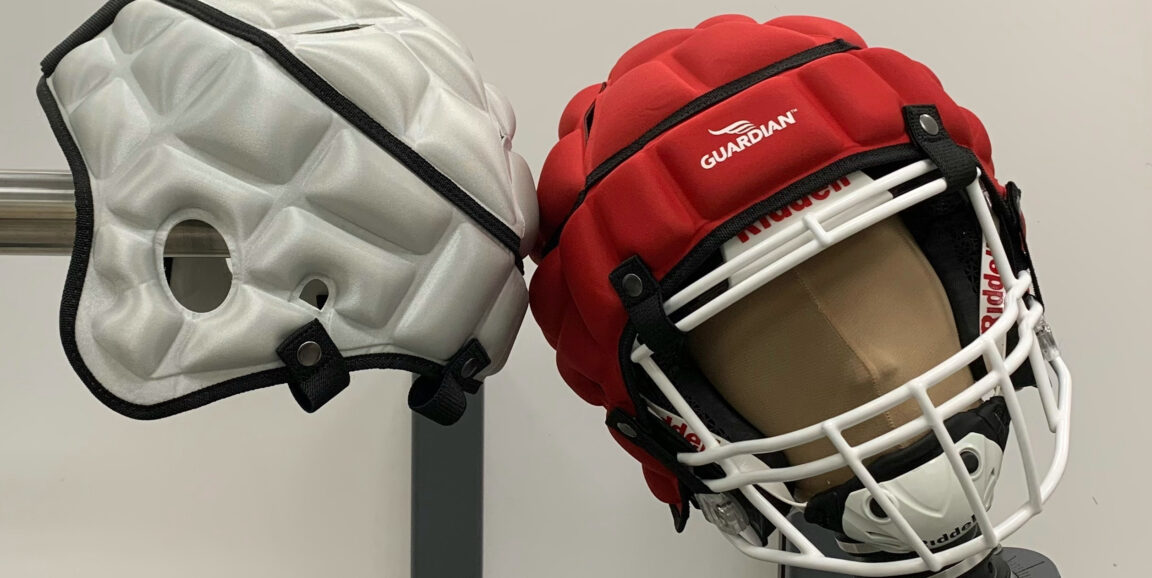As a former football player at Aptos High School in California and Princeton University, David Camarillo, PhD, an associate professor of bioengineering, experienced migraines from the head-banging the sport is known for.
He started wearing a padded cover attached to the outside of his helmet, hoping it would soften the blows. "The migraines were pretty painful," he said.
Football players particularly are prone to chronic traumatic encephalopathy, a type of cognitive and mental decline caused by the head pounding they repeatedly receive on the field. To protect players, sports equipment companies are constantly improving helmets. A new product similar to the padded cover Camarillo used to wear is on the market now; called the Guardian Cap, it's in vogue from high school fields to pro stadiums. In 2022, the National Football League began requiring players of certain positions to wear the new cap during training camp practices.
Does it help? According to Camarillo and his colleagues' research, published in Annals of Biomedical Engineering on March 14, if it provides a benefit, it's probably not substantial for the majority of hits players sustain.
"We need to do more and larger studies to see if the Guardian Cap has any impact," said Camarillo, the senior author of the study. "But I don't think it'll make a big difference for the kind of blows that don't lead to concussion but happen frequently on the field."
Simulated football
In a lab deep in the bowels of the Shriram Center for Bioengineering and Chemical Engineering on the Stanford University campus, Camarillo and his colleagues tested the cap. They attached a crash test dummy head, outfitted with motion sensors, to a dummy neck, and onto the head they strapped a helmet.
Using a mechanical battering device, they pounded the head at various angles and speeds, measuring the force of the blows. Then, strapping a cap atop the helmet and attaching another cap to the battering device, they gave the head more drubbings. They repeated the experiments at different temperatures and with different helmet brands. When the head and device sported the caps, the motion sensors showed little reduction in straight-on acceleration of the head.
The cap offered more protection for angular impacts, or hits that cause the head to rotate, than for straight-on blows. During angular impacts, the cap, which has a slick fabric exterior and attaches to the helmet with straps and Velcro, shifts like a loose-fitting wig. The researchers noted a wide range in the protection it offered, but on average the caps provided 15% to 20% more protection than blows to the head with only a helmet. In a few cases, the cap led to impacts becoming more dangerous.
"We don't think it's the padding that's providing most of the protection; we think it's the sliding of the cap along the helmet's surface," said Nick Cecchi, a graduate student in bioengineering who's a lead author of the study. "It redirects some of the impact energy when hit at the right angle."
Real-life tests
It's one thing to show results in a simulated environment with a fake head. What matters is whether the the cap protects football players' actual brains.
"The lab tells only part of the story, in an idealized situation," Cecchi said.
To test the cap on the field, the researchers outfitted mouthguards with the same motion sensor technology used in the dummy heads. Five linebackers on the Stanford University football team wore the mouthguards during practices for the 2019 season, when members didn't wear the cap, and five wore them in the 2021 season, when everyone wore the cap. Linebackers, who play a defensive position, take a lot of the blows that occur on the gridiron.
Watching video recordings from team practices during both seasons, the researchers noted 97 head-to-head collisions involving the linebackers and matched them with motion sensor data from their mouthguards.
They found that in the real-life football practices, the cap failed to show a significant reduction in the impact from blows that didn't cause concussion. Researchers believe such head banging, even in the absence of concussion, can contribute to the development of chronic traumatic encephalopathy.
A worthy investment?
The researchers were hesitant to support the cap, which costs about $50, but they noted that it's possible the cap provides some protection.
The difference between the lab results and those on the field may stem from the fact that many of the real-life impacts were blows to the players' face guards, where there's no protection from the cap, Cecchi and Camarillo said.
The study also did not control for different types of helmets the athletes wore on the field, which could affect the results, as helmets vary in how well they protect players, Camarillo said.
Finally, the study was small, limited to 10 players. A larger study incorporating data from more players in different positions could show it makes a difference, they said.
The researchers did not investigate the effect of the cap on the number of diagnosed concussions on the Stanford football team. While NFL officials are claiming that the cap has reduced the number of concussions in the preseason, Camarillo and Cecchi said they have not seen peer-reviewed studies showing that's the case.
As for future studies, they'd like to test the cap on high school players, given that teenage football -- with adolescent-playing styles and youthful heads -- may show different results.
"We would love to see how well this technology works at the youth and high school levels," Cecchi said. "That's where most of football is being played."
Photo by Nick Cecchi






